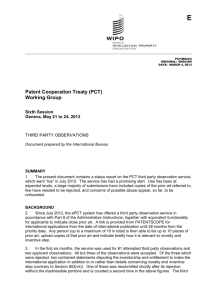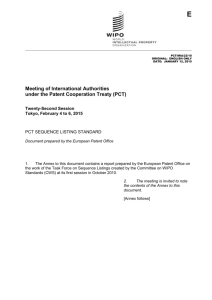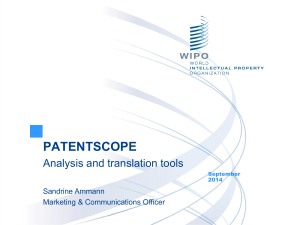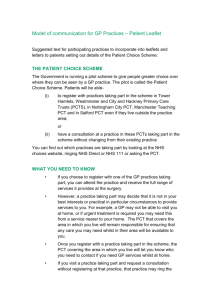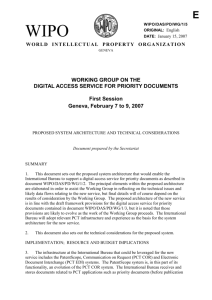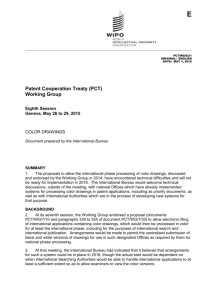PCT/MIA/11/8: PCT Minimum Documentation: Search
advertisement
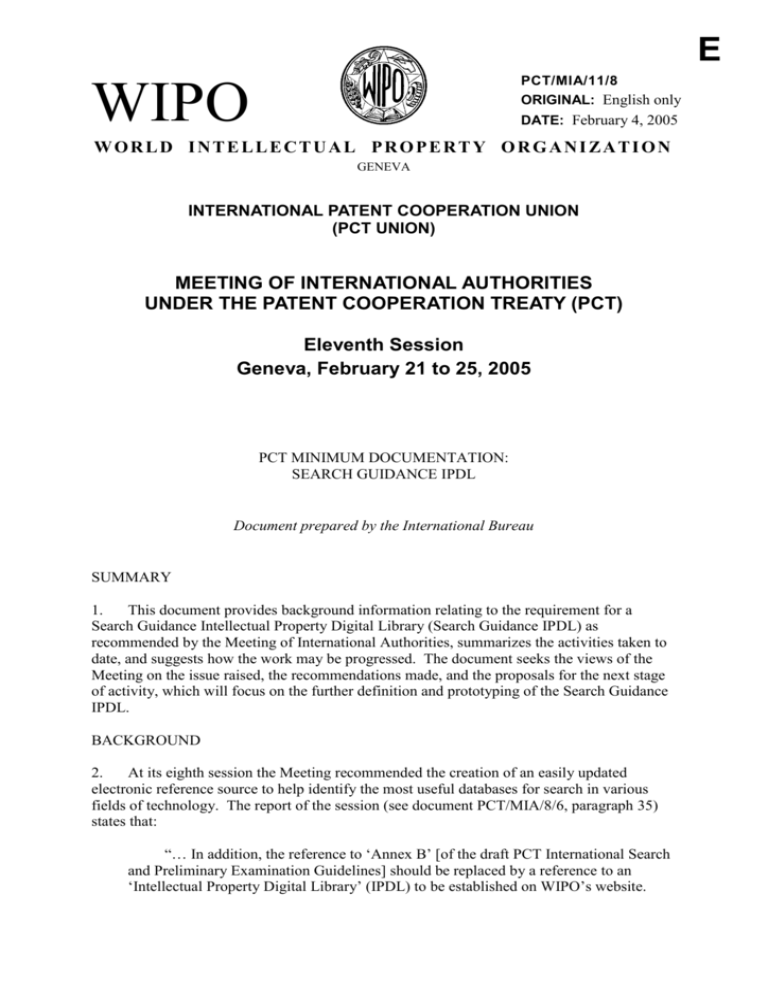
E PCT/MIA/11/8 WIPO ORIGINAL: English only DATE: February 4, 2005 WORLD INTELLECTUAL PROPERTY ORGANIZATION GENEVA INTERNATIONAL PATENT COOPERATION UNION (PCT UNION) MEETING OF INTERNATIONAL AUTHORITIES UNDER THE PATENT COOPERATION TREATY (PCT) Eleventh Session Geneva, February 21 to 25, 2005 PCT MINIMUM DOCUMENTATION: SEARCH GUIDANCE IPDL Document prepared by the International Bureau SUMMARY 1. This document provides background information relating to the requirement for a Search Guidance Intellectual Property Digital Library (Search Guidance IPDL) as recommended by the Meeting of International Authorities, summarizes the activities taken to date, and suggests how the work may be progressed. The document seeks the views of the Meeting on the issue raised, the recommendations made, and the proposals for the next stage of activity, which will focus on the further definition and prototyping of the Search Guidance IPDL. BACKGROUND 2. At its eighth session the Meeting recommended the creation of an easily updated electronic reference source to help identify the most useful databases for search in various fields of technology. The report of the session (see document PCT/MIA/8/6, paragraph 35) states that: “… In addition, the reference to ‘Annex B’ [of the draft PCT International Search and Preliminary Examination Guidelines] should be replaced by a reference to an ‘Intellectual Property Digital Library’ (IPDL) to be established on WIPO’s website. PCT/MIA/11/8 page 2 The text for that IPDL would be provided by, and would be maintained in the future by, the United States Patent and Trademark Office in consultation with the other Authorities. ...” 3. The PCT International Search and Preliminary Examination Guidelines discuss the Search Guidance IPDL (see paragraphs 15.16, 15.39, 15.41, 15.42, 15.43, 15.50, and 16.50 of document PCT/GL/ISPE/1), making the following points: (a) the international search should take into consideration relevant databases or other search resources such as those listed in the Search Guidance IPDL; (b) the Search Guidance IPDL is to appear on www.wipo.int; (c) technical areas and classification places are relevant fields in the determination of search resources; (d) where searches are made using the International Patent Classification system (IPC), the selection of classification places “IPC class codes” should be limited to codes of a parallel or more generalized level; this allows the searcher to find relevant material in analogous fields to the main classification places; (e) the Search Guidance IPDL should include specialized search systems, abstracting journals, and on-line databases; (f) the Search Guidance IPDL should indicate which technology areas require a non-patent literature search, in addition to a patent literature search. ACTION TAKEN 4. During the course of its activities the International Bureau developed a model and gave a presentation relating to the format, style, and content of a Search Guidance IPDL1. Feedback was sought during the tenth session of the Meeting, held in September 2004 (see document PCT/MIA/10/11, paragraph 49). 5. The Swedish Patent Office provided the following feedback via the electronic forum: “As regards the proposal to Search Guidance IPDL the Swedish Patent Office supports the outline of the system and finds that the system could be a useful tool for search of NPL [(non-patent literature)]. This tool is useful for journals not covered by any of the most common databases. It would be useful if there is an indication for each journal in which database the journal is included.” 6. In addition, the United States Patent and Trademark Office (USPTO) has provided the International Bureau with a copy of the intranet version of Search Guidance pages that the USPTO uses to support its Technology Centers. The International Bureau has reviewed the material provided. In principle, the data contained in the USPTO Search Guidance intranet 1 For more information refer to documents: http://www.wipo.int/pct/mia/en/min_doc/sgipdl/sgipdl_presentation.ppt and http://www.wipo.int/pct/mia/en/min_doc/sgipdl/sgipdl-example.ppt on the closed MIA forum. PCT/MIA/11/8 page 3 pages could be transferred into the Search Guidance IPDL. Review of, modification to, and supplementary information to the data may be required upon transfer, depending on the parameters used for the Search Guidance IPDL. For example, IPC class codes are not recorded in the USPTO Search Guidance pages. ISSUE - CONFIRMATION OF THE REQUIREMENT 7. The Search Guidance IPDL is expected to result in some (or all) of the following benefits: (a) the provision of a training/reference resource for examiners; (b) up to date guidance to support searching in emerging technologies, such as business cryptography; (c) the examiners in each of the International Authorities will be directed towards (and use) the same search resources (potentially this could increase the consistency of international search reports); (d) the provision of pointers to a dynamic “PCT search documentation” as opposed to the present “static” listings of PCT minimum documentation. 8. With regard to scope or coverage, the PCT International Search and Preliminary Examination Guidelines (document PCT/GL/ISPE/1) indicated that the Search Guidance IPDL should include non-patent literature sources including search systems, abstracting journals, and databases. The USPTO Search Guidance system includes references not only to NPL but also to patent documentation resources. As there are many parameters common to both patent collections and other data collections (journals and databases) – overlapping parameters including those such as coverage, access, volume of records, language, etc. – the International Bureau believes that, as with the USPTO Search Guidance pages, both patent documentation and NPL should be included. The Search Guidance IPDL could then logically be thought of as a central repository of information about PCT minimum documentation and other value added data sources. 9. In practical terms, it is proposed that the Search Guidance IPDL would include: (a) all non-patent literature as currently defined by Rule 34; (b) all patent literature as currently defined by Rule 34; (c) popular online access points to multiple data collections (such as Thomson DIALOG and Elsevier multi-media publishing sites). 10. These items are considered to add value to the Search Guidance IPDL so as to provide a meaningful sized database that will not impose unreasonable administrative overheads. 11. With respect to purpose, at this stage the International Bureau has assumed that the Search Guidance IPDL is not expected to allow for searching of the data records and articles within the data sources but, rather, that it is to be a search precursor step allowing the identification of data sources, and that searching of the data sources is a subsequent step in the search process. In other words the purpose of the Search Guidance IPDL is to: PCT/MIA/11/8 page 4 (a) help identify (and link to) the most time-efficient and/or cost-effectively searchable electronically available data sources (including databases, publisher sites, periodicals, and abstracting journals) suitable for search in specifiable fields of technology and/or IPC class codes; and (b) give useful advice regarding the identity of, coverage in, access to, and context of these data sources. 12. To aid confirmation of the requirements for the Search Guidance IPDL the International Bureau is developing a working prototype which is based on the above considerations and draws on the presentation made, and model demonstrated, at the tenth session of the Meeting. The objective of the prototype is to encourage further discussion and feedback. The prototype is being prepared as a Microsoft Access database for eventual deployment as a web based interface to the WIPO website. The prototype is being developed in phases, the first phase of which has been the preparation of proposed Search Guidance data input screens. The prototype data input entry screens serve to illustrate those fields that are useful for both data entry and subsequent display of search results. At this stage, the prototype contains a limited set of data records. Further phases of the prototype development will involve: (a) the preparation of query screens based on IPC class, subject areas, text strings, and/or data source type. Such queries will be designed to limit the data sources to be a manageable and relevant list of results. (b) preparing a way of returning results to the examiner that can be refined, used, and exported to a case file in a way that is meaningful and time efficient. PROPOSED NEXT STEPS 13. The International Bureau encourages the Meeting to provide feedback about the Search Guidance IPDL, particularly with regard to its purpose, scope, and definition. In support of this aim, the International Bureau proposes the establishment of a task force comprised of International Bureau project staff and representatives from the International Authorities to confirm the requirements of the Search Guidance IPDL and oversee the development of a working prototype for subsequent presentation to the Meeting. 14. The Meeting is invited to confirm the requirements of the Search Guidance IPDL and approve the proposed next steps contained in paragraphs 7 to 13, above. [End of document]
